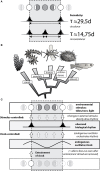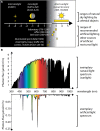An Overview of Monthly Rhythms and Clocks
- PMID: 28553258
- PMCID: PMC5428424
- DOI: 10.3389/fneur.2017.00189
An Overview of Monthly Rhythms and Clocks
Abstract
Organisms have evolved to cope with geophysical cycles of different period lengths. In this review, we focus on the adaptations of animals to the lunar cycle, specifically, on the occurrence of biological rhythms with monthly (circalunar) or semi-monthly (circasemilunar) period lengths. Systematic experimental investigation, starting in the early twentieth century, has allowed scientists to distinguish between mythological belief and scientific facts concerning the influence of the lunar cycle on animals. These studies revealed that marine animals of various taxa exhibit circalunar or circasemilunar reproductive rhythms. Some of these rely on endogenous oscillators (circalunar or circasemilunar clocks), whereas others are directly driven by external cues, such as the changes in nocturnal illuminance. We review current insight in the molecular and cellular mechanisms involved in circalunar rhythms, focusing on recent work in corals, annelid worms, midges, and fishes. In several of these model systems, the transcript levels of some core circadian clock genes are affected by both light and endogenous circalunar oscillations. How these and other molecular changes relate to the changes in physiology or behavior over the lunar cycle remains to be determined. We further review the possible relevance of circalunar rhythms for terrestrial species, with a particular focus on mammalian reproduction. Studies on circalunar rhythms of conception or birth rates extend to humans, where the lunar cycle was suggested to also affect sleep and mental health. While these reports remain controversial, factors like the increase in "light pollution" by artificial light might contribute to discrepancies between studies. We finally discuss the existence of circalunar oscillations in mammalian physiology. We speculate that these oscillations could be the remnant of ancient circalunar oscillators that were secondarily uncoupled from a natural entrainment mechanism, but still maintained relevance for structuring the timing of reproduction or physiology. The analysis and comparison of circalunar rhythms and clocks are currently challenging due to the heterogeneity of samples concerning species diversity, environmental conditions, and chronobiological conditions. We suggest that future research will benefit from the development of standardized experimental paradigms, and common principles for recording and reporting environmental conditions, especially light spectra and intensities.
Keywords: circadian; circalunar; light; marine; mood; moon; reproduction; sleep.
Figures


References
-
- Naylor E. Chronobiology of Marine Organisms. Cambridge: Cambridge University Press; (2010).
-
- Numata H, Helm B, editors. Annual, Lunar, and Tidal Clocks. Heidelberg: Springer; (2014).
Publication types
Grants and funding
LinkOut - more resources
Full Text Sources
Other Literature Sources

